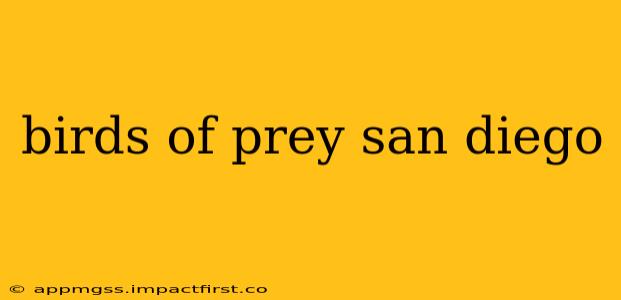San Diego, with its diverse ecosystems ranging from coastal cliffs to mountain ranges, provides a haven for various bird species, including several impressive birds of prey. Spotting these magnificent creatures in their natural habitat is a thrilling experience for bird enthusiasts and nature lovers alike. This guide explores the different birds of prey you might encounter in San Diego, where to find them, and what to look for when observing them.
What Birds of Prey Can I See in San Diego?
San Diego boasts a rich variety of raptors. Some of the most commonly sighted include:
-
Red-tailed Hawk: This is perhaps the most ubiquitous bird of prey in San Diego, easily identifiable by its reddish-brown tail and broad wings. They're adaptable and can be found in various habitats, from open fields to urban areas.
-
American Kestrel: This small falcon is a vibrant sight, with its rufous back, blue-gray wings, and distinctive facial markings. They often perch on utility poles and fence posts, scanning for insects and small rodents.
-
Cooper's Hawk: A slightly larger and more agile hawk than the red-tailed hawk, Cooper's hawks are known for their swift, acrobatic flights. They prefer wooded areas but may also be seen in parks and suburban settings.
-
Peregrine Falcon: The fastest animal on Earth, the peregrine falcon is a thrilling sight. While less common than other raptors, they can be observed along the coast and near cliffs, where they hunt for birds in flight.
-
Bald Eagle: While not as common as other birds of prey on this list, the majestic Bald Eagle can occasionally be spotted in San Diego, particularly near bodies of water. Their size and distinctive white head and tail make them unmistakable.
-
Northern Harrier: This marsh hawk is a graceful hunter, often seen gliding low over grasslands and marshes. Their distinctive hovering flight and long tails are easy to identify.
Where Are the Best Places to See Birds of Prey in San Diego?
Several locations in and around San Diego offer excellent opportunities for birdwatching:
-
Mission Trails Regional Park: This expansive park features diverse habitats, including grasslands, chaparral, and riparian areas, attracting a variety of birds of prey.
-
Torrey Pines State Natural Reserve: The dramatic cliffs and coastal habitats provide nesting and hunting grounds for peregrine falcons and other raptors.
-
Anza-Borrego Desert State Park: While further afield, this park offers stunning desert scenery and opportunities to observe birds of prey adapted to arid environments.
-
Lake Murray: This reservoir is a good place to spot Bald Eagles and other water-loving raptors.
What is the Best Time of Year to See Birds of Prey in San Diego?
While birds of prey can be seen year-round in San Diego, the best time for viewing is generally during migration seasons (spring and fall) when many species are moving through the region. Breeding season (spring and summer) also offers good opportunities to observe nesting birds.
What Equipment Do I Need to See Birds of Prey?
Binoculars are essential for observing birds of prey in detail. A spotting scope can enhance your viewing experience, especially at longer distances. A field guide to birds of prey can help you identify the species you see.
Are There Any Guided Birdwatching Tours in San Diego?
Yes, several companies offer guided birdwatching tours in San Diego. These tours can provide expert insights into bird identification, behavior, and habitat.
What Should I Do If I Find an Injured Bird of Prey?
If you encounter an injured or distressed bird of prey, do not approach it. Contact a local wildlife rehabilitation center immediately. They have the expertise and equipment to handle these situations safely and effectively. Avoid handling the bird yourself, as you could risk injury to both yourself and the animal.
By exploring these locations and following these tips, you'll significantly increase your chances of witnessing the breathtaking beauty and power of San Diego's birds of prey. Remember to respect their habitats and observe them from a safe distance to ensure their well-being. Happy birding!
